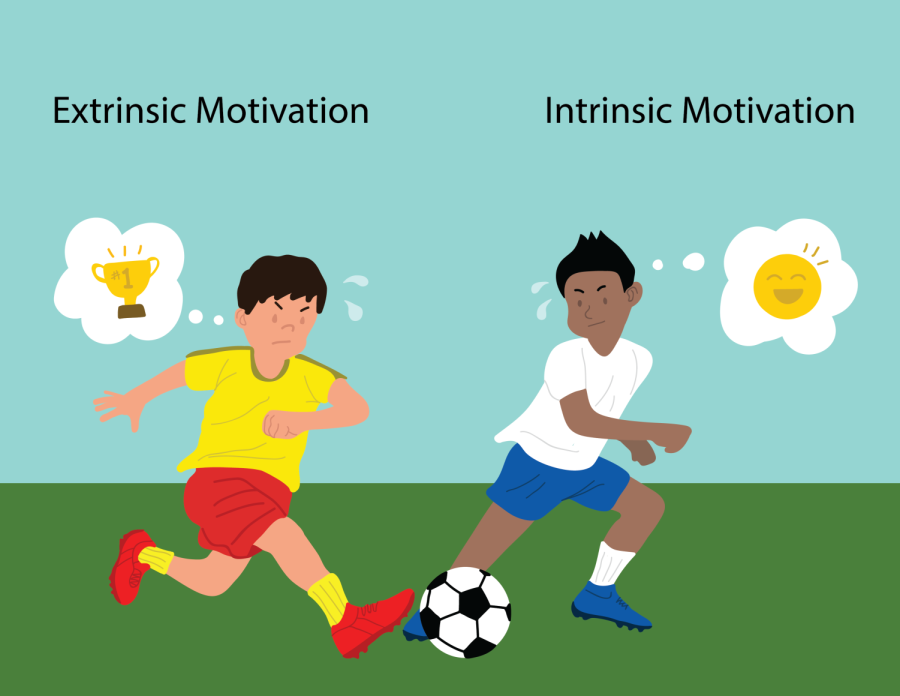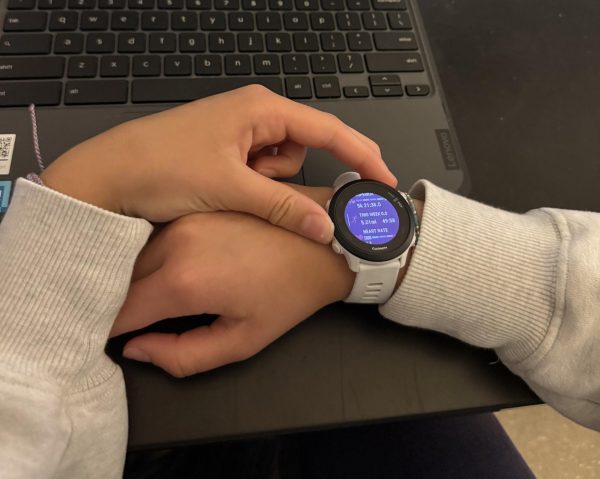Learning over school: Relearning the intrinsic value of education after a year online
Image used with permission from Google Commons
Intrinsic vs. Extrinsic motivation – playing to play vs. playing to win.
In 1838, “father of modern education” Horace Mann helped to establish the first modern public schools in America. Adjusted to meet the needs of 19th Century Americans amidst the industrial revolution, Mann’s system was quickly adopted all over the country, and tuition-free education became an essential part of the American dream. For almost two centuries, American public schools remained fundamentally the same. They became ingrained in American culture and in the American experience to the point that a world without them seemed unimaginable. They were unavoidable; They were a fact of life.
Then, in the spring of 2020, the unimaginable happened. A global pandemic hit and schools were uprooted. Some buildings closed for weeks, others for more than a year. The change had an impact on everyone, hitting some families harder than others, but across the board one thing was true: For the first time in two centuries, there was room to question what had previously been unquestionable.
Chana Joffe-Walt from This American Life explored the issue in an episode titled School’s Out Forever. The episode centers her conversations with parents, students and teachers affected by the pandemic. “School had always been this solid object that now seems much less solid,” she said. “So many of the people I’ve been speaking with are questioning the very premise of school, whether it’s worth it, whether they need to show up every day, whether they need to be in a classroom. It’s like everyone involved — kids, parents, drivers, teachers, superintendents — all realized at the same time, hey, this treadmill has an off switch. This place is not fact. School is not inevitable.”
Before the pandemic, ‘chronic absenteeism’ was a term typically applied to students who missed at least 18 days – or 10% – of the school year. That’s because once a student misses 18 days, they’re at significantly higher risk for being held back and even dropping out in the future. During the pandemic, however, not only did more kids fall into this category than ever before, but a survey from the Department of Education revealed that students were increasingly missing 50-60% of school days: absent more often than they were present.
Even among students with consistent attendance, learning loss was still a significant issue. There were countless factors playing into this, such as severe staff shortages across the country and rising mental health issues among both students and teachers, but the most significant was likely the fact that “attendance” didn’t really mean anything in a lot of classes. At this school, at least, teachers often marked students present as long as they logged into Zoom at the beginning of class and unmuted to say “here” during attendance, regardless of whether or not they spent the rest of the period with their microphone and camera off. I, for one, slept through most of my classes after being marked present. Still, even when I was trying to engage, it was (unsurprisingly) extremely difficult to do so when my learning environment was on my laptop in my room and consisted of 30 black boxes and one teacher’s face.
I wasn’t the only one disengaged. From what I’ve observed, isolation and the lack of a proper learning environment during online instruction seem to have been the biggest contributors to learning loss among students at this school. Nearly every student was cheating, and every teacher seemed to have known it was happening. In fact, in a survey of 100 seniors conducted for Volume 51 Issue 4, 14 of every 15 students said they had cheated. educ
It was obvious at the time that even students privileged enough to attend online school consistently weren’t learning what they were meant to. But, can you blame them? With everything going on in the world, in our communities and within families in 2020, it’s no wonder students were unwilling or unable to prioritize school work above all else. Even if they had, the conditions of online instruction made it nearly impossible to actually learn.
In my own classes, teachers seemed just as preoccupied with current events as their students, if not more so. More often than not they seemed dispassionate and disconnected from the material they were teaching, which was completely understandable considering that their lessons were usually directed at a screen of silent nametags. Still, students can’t be expected to apply themselves when even their teachers seem uninterested in the course material. Students were no longer attending school for the purpose of learning and growing. They were attending school because they had to.
While schools were closed, I was one of many students who began questioning the necessity of school. What was the point? I wasn’t learning. The only reason I had to do work at all was for grades. But those didn’t matter to me, they mattered to my parents. Why should I have to spend eight hours a day doing work alone in my room just to earn a letter on a report card that meant nothing to me?
The motivation that drives students to do their work can be separated into two categories: intrinsic and extrinsic. Intrinsic motivation is the drive students have when their work is personally rewarding to them, like when they enjoy reading or studying a certain subject, or when they love learning in general. Extrinsic motivation, on the other hand, is driven by rewards and punishments, i.e. getting a good grade and avoiding a bad one.
While both intrinsic and extrinsic motivation are important in helping students to develop good study habits and investment in school, research has shown that when students are intrinsically motivated, they are more likely to attach meaning to their work, explore new topics, and persist when they are challenged.
There are a few factors that influence intrinsic motivation in students. Three of these factors stand out when discussing students’ motivation during online learning: control, recognition and cooperation. Firstly, students need to have a sense of autonomy and control over their education, whether it be the subject, the pacing, or the timing of a class in their schedule. Secondly, people have an inherent desire to be recognized and appreciated for their efforts. Lastly, students are motivated by collaboration and cooperation with their peers, as well as the competition that social learning environments provide. All three of these factors were missing when learning went virtual in 2020.
This doesn’t mean that students lost motivation completely, but it does mean that for the most part, they were relying on extrinsic motivation. I wanted to see just how many students relied on external rewards and punishments to get work done at school, so I posted a poll for students following my Instagram. I asked students which factors motivated them the most in school: internal factors (love for learning or interest in specific subjects), or external factors (academic achievement, grades, or validation). 89 students responded to the poll. 71% said they were externally motivated, while only 29% said they were internally motivated.
I asked some of the respondents how their perception of school changed once they stopped going in person, and how that was affecting them now. Junior Haven Golliday said she regretted not learning in her online classes. “Going online made me not take school as seriously for sure. It made me not think of it as super important anymore, or something to truly focus on. It was easier to get around. I regret not taking it more seriously. I did well, but I didn’t actually learn the material. It was easier to get things done without learning the content, and it’s made this year a lot harder for me,” Golliday said.
Junior Akshara Raju had a similar experience. “I realized I didn’t need to put in actual effort to do well in school, so I stopped paying attention. I didn’t care about learning. I didn’t actually learn anything all year, because I didn’t pay attention. There was no point in paying attention. I’m a lot more stressed now. I got so used to cramming and procrastinating that I feel like I can’t handle the workload anymore,” Raju said.
Relying on extrinsic motivation comes with several drawbacks. Extrinsic motivation doesn’t create passion. Students who rely on it will often do the bare minimum to get their reward, which may lead them to cheat or forget information when they no longer need it for a grade. In addition, relying on extrinsic motivation sets a dangerous precedent. When students are only learning to achieve something, they won’t see the point of learning when it’s detached from an immediate reward, which will hinder their ability to learn in the future.
In School’s Out Forever, Joffe-Walt discusses the experiences of students who fell behind during the year online. “School is a machine that is designed to move forward. Kids move class-to-class, grade-to-grade. The machine does not stop. It’s not designed to go back in time, to meet [students] where [they’re] at right now,” she said.
The past two years have exemplified the importance of learning for the sake of learning, and the ways in which emphasis on grades and achievements have hindered students’ ability to do so. My goal with this article is to encourage students to stop doing work for the sake of achievement and start doing it for themselves. You are in school to learn, not to succeed, and while grades and recognition should help motivate you, they should not be the only things that keep you going.
Your donation will support the student journalists of Thomas S. Wootton High School. Your contribution will allow us to purchase equipment and cover our annual website hosting costs.
Senior Isaac Muffett is the opinions editor in his fourth year on the Common Sense staff. When he's not writing or researching, he spends his free time...








Anonymous • Oct 4, 2022 at 4:44 pm
The way the illustration depicts the idea is either intentionally or unintentionally enforcing the untrue stereotypes of different racial groups. Wish the authors of this article would be more considerate. Other than that it’s a reasonable interesting piece.